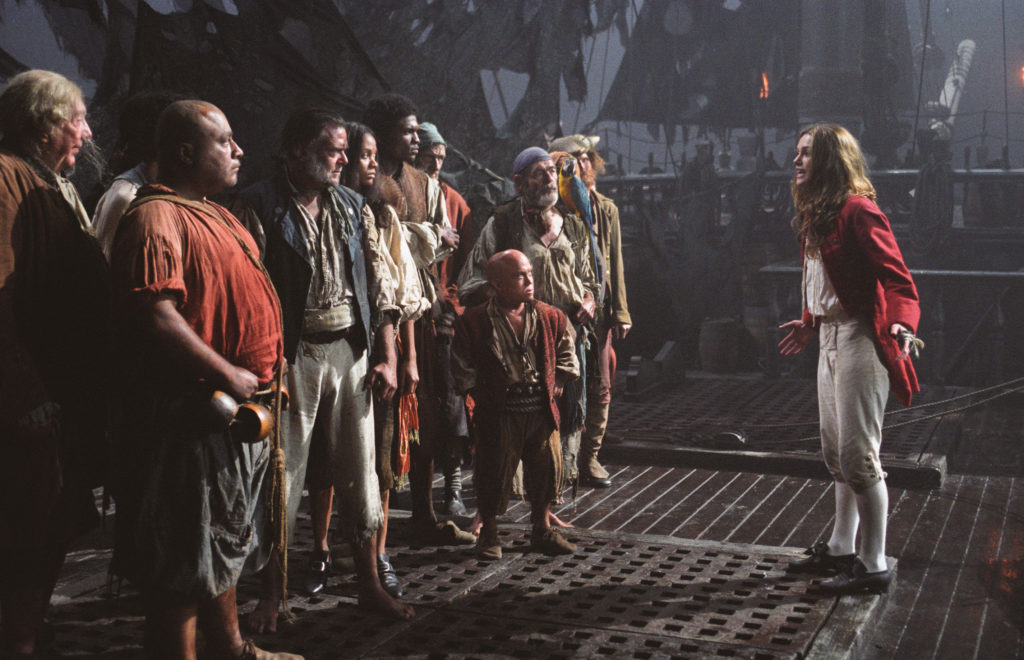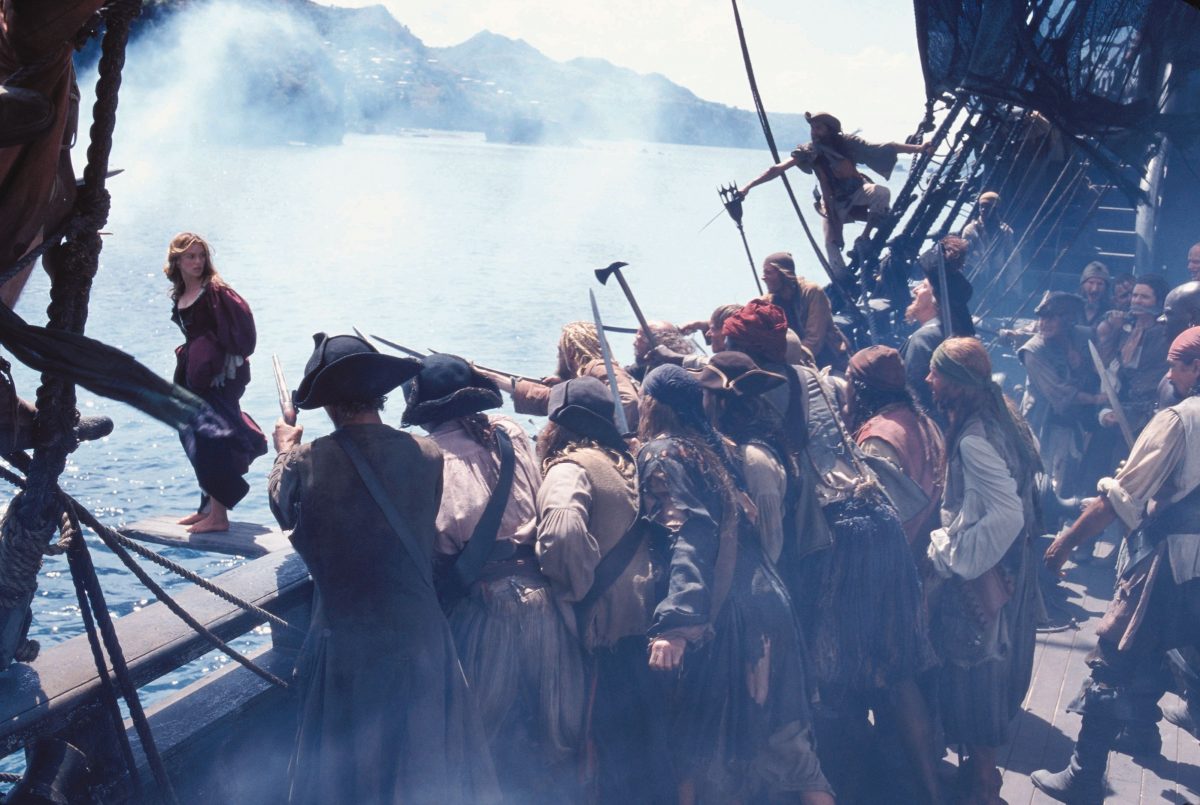Recently, my boyfriend and I decided to revisit a childhood classic: Pirates of the Caribbean: The Curse of the Black Pearl, the film that jump-started what would prove to be an extremely lucrative and much beloved franchise for Disney. I first watched it not long after its 2003 release, making me 8 or 9 at the time, and enjoyed it, like most other children at the time. It brims with swashbuckling adventure and humor while maintaining Disney’s family-friendly directive. Unfortunately, with my older, more world-weary eyes saw through the dust of nostalgia, dismayed as the film makes no effort to pass the Bechdel-Wallace Test, which stands as an absolute bare minimum requirement for a creative endeavor’s portrayal of women.
Congratulations, Pirates: You Did the Absolute Least You Possibly Could
A handful of women in appear in The Curse of the Black Pearl, only one of whom boasts a significant role in the film. Keira Knightley plays Elizabeth Swann, the female lead and romantic interest of early-noughties dreamboat Orlando Bloom, best known for his turn as Legolas in The Lord of the Rings, possessor of elf-eyes and occasional gay lover to the hotter, more rugged Aragorn (disclaimer: I have not read much Tolkien). A pre-blue alien CGI and green alien body paint Zoë Saldana pops up as Anamaria roughly a third of the way into the film, a member of Jack Sparrow’s (Johnny Depp) ragtag crew. Her name is mentioned approximately once. The remaining named women are Estrella, Elizabeth’s maid, who appears in a brief scene (no more than a few minutes), along with Scarlett and Giselle, who are implied to have had sex with Johnny Depp’s character.
While the latter three women exist, albeit as extremely minor characters, their presence can hardly be considered exceptional, as they are either servants or sex objects. That said, with a count of four named women compared to at least twice that of men, the film nonetheless coasts by the first criteria of the Bechdel-Wallace test: to include at least two named female characters.
It Is a Truth Universally Acknowledged…
The sole scene involving two women conversing with one another is the aforementioned scene with Estrella, when she chats with Elizabeth. The Curse of the Black Pearl thus passes the second criteria of the Bechdel-Wallace test (to have two women speak to each other), but the subject of their conversation leads to the film’s ultimate failure.
Estrella and Elizabeth chat about the latter’s impending engagement to Commodore Norrington, a man. The two women gab about it being a “lucky match,” given the Commodore’s high-ranking within society, but Elizabeth balks, in part because her fiancé-to-be tragically resembles Nicholas Cage, and also because she is in secret love with Will Turner (Orlando Bloom), a common blacksmith. The film therefore implies some sort of female friendship, as Estrella and Elizabeth are in close enough confidence for Estrella to know Elizabeth’s heart. However, Elizabeth dismisses Estrella for speaking out of turn (code for speaking to her while being a Filthy Poor), the power dynamic ceasing any sort of meaningful conversation about hierarchies of power, gender, and class, reducing their conversation to the mere romantic gossip of the day.
So we’re all men of our word really… Except for, of course, Elizabeth, who is, in fact, a woman, and therefore has nothing interesting or valuable to say.
– Captain Jack Sparrow
The limited nature of this conversation is unfortunate considering how easily it could have been elevated beyond womanly chatter. Elizabeth’s rejection of traditional norms and values within the film isn’t limited to just her romantic choices (though that’s certainly the focus of her plotline), but also her fascination with the forbidden world of pirates. Elizabeth chiding Estrella for forgetting her place seems particularly out of character in this context too, as the audience is meant to understand Elizabeth as not only resistant to the structures of power but also as compassionate to the lower-class. Her shutting down the conversation may have been a mere attempt by her to avoid admitting her feelings for Will, but plays out more like the movie not wanting to waste time with the conversations of women and fleshing out Elizabeth’s character. This potential sits just below the film’s waters, but the filmmakers fail to surface it.
This repudiation of society by Elizabeth remains present in the film, but mostly exists within the context of her romance with Will. She jaunts around with Jack Sparrow and outsmarts several pirates, but is also subject to their sexual harassment, stemming not only from her captors (oh yeah — Elizabeth acts as the damsel in distress for much of the film) but also from Jack. Regarding the latter, his harassing Elizabeth is played not to be disturbing, but for the audience’s humor and enjoyment, like when Sparrow asks if Elizabeth might be hiding something in her bodice, gazes at her chest, and remarks that it’s unlikely given the size.
The film thus attempts to endear the audience to Sparrow by way of objectifying and mocking Elizabeth. It seems a particularly ill-conceived joke as well considering that part of Keira Knightley’s daily makeup session for the film was a whooping 45 minutes dedicated to making her breasts look larger and to give her what she calls “the cleavage effect.” She described the experience positively in that same interview with the Daily Mail in February of 2008:
They painted my tits on me for the films, which is extraordinary because it’s kind of a dying art form – in the past, they used to have whole sections of the studios devoted to bosom make-up… And I loved it, completely loved it. Because it was the first time in my life I had big tits, and I didn’t even need surgery.
While women are free to choose to have breast augmentation surgeries or employ other methods of making their chests look fuller, we must question from where the desire stems. Tabloids and media have scrutinized Knightley’s body all through her career, criticizing her thin frame. Filmmakers and advertisers have deemed her body as something needing to be changed, like when her breasts were digitally edited in promotional material for her 2004 film King Arthur (see picture right). By July of 2008, just a few months after the interview about Pirates, Knightley took a stand: while she perhaps hadn’t cared in the past, she did now. She refused any makeup or Photoshop tricks to “enhance” her chest for her 2008 film, The Duchess, citing her pride and comfort in her body. A gorgeous, slender woman like Knightley — with fame to boot — of course has a degree of privilege in the complicated world of body image, as she more or less represents the ideal constantly presented to women. However, her stance against altering her natural appearance for the male gaze remains notable, especially when analyzing the first Pirates film: while Elizabeth might quip about corsets, the film’s rebellion against contemporary beauty standards and progressive attitude towards women remains completely superficial. The film continues to perpetuate the very standards it pretends to diverge against.
To return to the treatment of Elizabeth’s character by other characters in the film, in another scene, Elizabeth infamously burns a cache of alcohol to create a signal fire when she and Jack have been marooned on an island. Lamenting his now forced sobriety, Jack quips, “there’ll be no living with her after this,” his personal twist on the delightful aphorism “women, can’t live with ’em, can’t live without ’em.” The truth in his jest is that a determined woman like Elizabeth (Jack is content to waste away on the island) cannot be borne unless one is intoxicated.

In the final battle of the movie, Elizabeth appears in a solider’s coat and pants; her dress was soaked and she had to change for decency and to avoid pneumonia (despite that the many men in the film are constantly drenched — the implication here being that women are more delicate). It’s a refreshing change from the corsets and large dresses she spends the rest of the film in (though she returns to them by the film’s end), but the shots with Knightley in the costume are short and easy to miss in all the action. She barely participates in the fight and almost never without the assistance of a man, usually Will. The conception of her character may point to a progressive portrayal of a woman, but utterly fails in execution; the filmmakers want to have their cake and eat it too. They mock corsets, but seemingly agree with their purpose.
Anamaria too represents wasted potential in Pirates of the Caribbean, an opportunity to elevate the film’s inclusion of women beyond servants and sex objects. A fully realized character for Anamaria would have been especially notable as it would feature a woman of color in a non-sexualized, non-servile role. In her first scene, Anamaria admonishes Jack for his owing her a ship, implying a swashbuckling or sailing history on her part. But after she is established as part of Jack’s ragtag crew, she appears only in the background and speaks only to confirm her orders from Jack Sparrow or the first-mate, Gibbs. A woman’s presence on a ship in the era of course would have been notable, and Anamaria could have been an interesting counterpart for Elizabeth — inspiration to ultimately commit to a life as a pirate — as well as an interesting character in her own right. Once again, however, the movies see fit to not spend their time on such a plotline, let alone on allowing these two women to interact.
I Have Exactly One Emotion, Ever, and It Is ‘Disappointed’
Pirates of the Caribbean at least makes some effort to include women and bandies interesting directions and back stories for them, but fails to translate them into anything substantial. It certainly had opportunity to, with many critics agreeing that scenes in the film ran long and could have been edited down significantly, as well as much of the plot’s back-and-forth reduced. That time could instead have been dedicated to developing these interesting characters, rather than the repetitive antics of inconsequential pirates. Yes, it’s a movie about pirates; they’re literally in the title. But why can’t women be those pirates? Why can’t they be a major part of the action, without having to be helped, rescued, or protected? Why can’t they exist without being madonnas, whores, servants, or scorned women?
I lack clear recollections of the franchise’s later films, though most agree that their quality deteriorates after the second film. From what I do remember, they fail to add many more female characters to the mix, though Elizabeth remains in at least the next two, and she is presumably given more to do than be rescued by Will (hopefully). The Curse of the Black Pearl passes only the first two criterion of the Bechdel-Wallace test, but the test itself represents an ankle-high bar that, sadly, most films continue to trip over, Pirates of the Caribbean included.
I originally wrote this for an assignment in a Diversity & Education course; I have modified the tone and expanded the content for this blog.





Leave a Reply